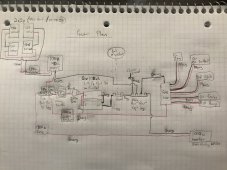Thank you for catching that. This is what the specs say: Max Amps: 100A per block, 30A per circuit.
I was thinking that if I had say, three of the circuits each pulling 30a then I might get 90a or more into the block itself and needed the bigger wire. Realistically I'm not going to be close to 100a through the block so I can probably downside but I was attempting to allow room to scale up if I did need the extra power. Am I thinking about that right when I read the specs at 100a per block?
Yes the max aggregate fault current for the fuse block is 100 amps.
The max fault current for each branch circuit is 30 amps.
Beefing up one of the branch circuits won't do much to help the fuse block as a whole.
Fun fact... since the max fuse size for a branch circuit is 30 amps that means the max continous current on that circuit should be no higher than 24 amps.
I'm trying to account for voltage drop and making sure there's as little as possible between the battery and the fridge. It's about 25ft of wire one way unfortunately.
Battery Chargers, Inverters, Solar Components, and Wiring Supplies for Boats, RVs, and Off-Grid Applications.

baymarinesupply.com
The input data points are system voltage, round trip circuit length and amps.
The only thing I don't know is amps.
If you want to keep the voltage drop to a minimum you can terminate this circuit on the core busbars instead of the fuse block.
8 awg is no problem in that case.
Last question since you were so knowledgeable about wire size. I'm using two of these batteries...12v 100ah
The website says the can be wired together using 4awg.
Those can be wired to the busbars individually with 4 awg.
If you want to parallel the batteries before they get to the busbar then you need wire for twice the current.
Each of those batteries can deliver 100 amps continuous.
100 amps * 2 batteries = 200 service amps.
200 service amps / .8 fuse headroom = 250 fault amps.
That means 1/0 awg wire with a 250 amp fuse for the pair.
Or 4 awg wires with 150 amp fuses per battery.
To figure the wire and fuse for your inverter....
1000 ac watts / .85 conversion factor / 10 volts low cutoff = 117.647058824 service amps
117.647058824 service amps / .8 fuse headroom = 147.058823529 fault amps
That means you could use 4 awg with a 150 amp fuse.
But that is really close to the edge so I would use 2 awg wire with a 200 amp fuse.
But nothing I read showed that as enough so I was going to step up to 2 or even 2/0awg as some wire size calculators have said. any sources of information I should look to to help determine the largest size wire I would need for a system with two of those in parallel? I'd use that for the batteries, run to the switches and bus bars, shunt, as well as the chassis ground.
See in-line response above ^




